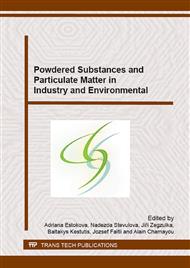p.140
p.146
p.153
p.161
p.171
p.182
p.188
p.197
p.205
Chemical Compositon of PM10, PM2.5, PM1 and Influence of Meteorological Conditions on them in Zilina Self-Governing Region, Slovakia
Abstract:
Particulate matter (PM) is one of the striking pollutants and causes appreciable degradation of the environment and therefore the quality of life of the population. PM may originate in various natural resources or anthropogenic sources. Among the natural sources sea salt is to be counted on, dust of the earth crust, pollen and volcanic ashes. Anthropogenic sources do include, predominantly, burning fossil fuels in the fossil-fuel power plants, local heating of households, burning liquefied fossil fuels in the combustion engines of vehicles, non-combustion related emissions as a result of vehicular traffic, resuspension of the road-traffic-related dust. Their harmful effect and impact on the ambient environment is determined predominantly by the aerodynamic diameter of PM and by the presence of various chemical substances and elements. The subject of this presentation is monitoring particulate matter along the cycle of its creation in the vicinity of highway in rural area and an evaluation of fraction ratios PM10, PM2.5 and PM1 with regard to meteorological conditions and traffic volume. Wind speed and temperature appear to be the most significant meteorological factors with proven impact on particulate matter in ambient air. The fine fraction PM2.5 is determining for the total measured fraction PM10. It has also been monitored the chemical composition of PM, in particular the presence of metals in fractions of PM. Some chemical elements (metals) are characteristic for fine fraction PM2.5 and some for coarse fraction PM2.5-10. It depends primarily on measuring seasons, the distribution of potential sources of particulate matter and metals in the time and space.
Info:
Periodical:
Pages:
171-181
Citation:
Online since:
October 2015
Authors:
Price:
Сopyright:
© 2016 Trans Tech Publications Ltd. All Rights Reserved
Share:
Citation:


